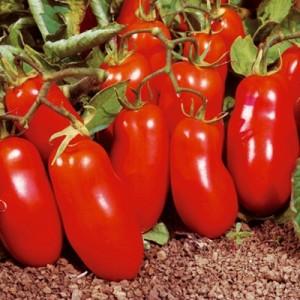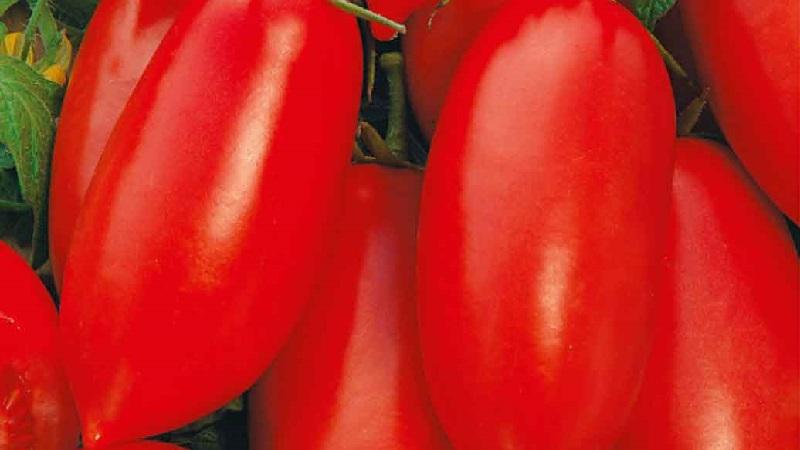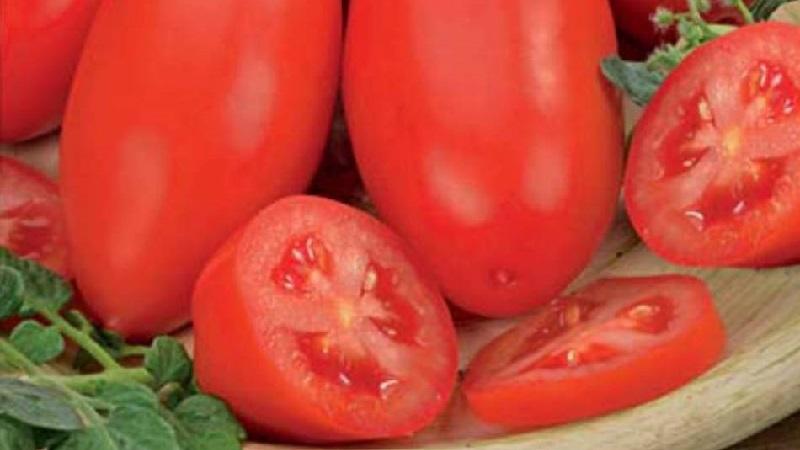A gift for novice gardeners - the "Shuttle" tomato is unpretentious in care and rich in harvest
Due to its high yield and unusual shape, the Tomato Shuttle is of interest to summer residents. It is famous not only for its yield, but also for its extreme ease of care: an ideal variety for novice summer residents. Shuttle tomatoes are resistant to frost, unpretentious in watering and in the place of their planting.
In this article, you will find step by step instructions on how to properly prepare seeds for planting, learn how to care for sprouts and harvest your own home crop.
The content of the article
Tomato Shuttle: characteristics and description of the variety
A distinctive feature of this variety of tomatoes is the compactness of the bushes and early maturity. The shuttle does not grow more than 50 cm, which allows you to grow it at home: on loggias and balconies.
 Tomatoes ripen within 95 days after sprouting, so the variety is called early maturing. Medium-sized fruits with a pleasant taste have a specific elongated shape and appear already 3 months after transplanting to the greenhouse or 3.5 months if the transplant was carried out in open ground.
Tomatoes ripen within 95 days after sprouting, so the variety is called early maturing. Medium-sized fruits with a pleasant taste have a specific elongated shape and appear already 3 months after transplanting to the greenhouse or 3.5 months if the transplant was carried out in open ground.
The Shuttle bears fruit almost all summer, right up to autumn frosts.
The yield of the variety does not fail: with a fairly dense planting (about 10 bushes per 1 sq. m.), 8-9 kg of fruits are harvested from each meter. That is why this variety is so popular with farmers: you can plant close to each other, do without pinching and garters (since the size of the plants is small), while collecting a large crop.
When the fruit acquires a bright red hue and a cylindrical shape, similar to bell peppers, we can talk about its ripeness.
Shuttle tomatoes are dense and fleshy, do not spread or sag when cutting. The weight of each fruit is about 50-60 g. They tolerate temperature changes, transportation well, lie for a long time and do not deteriorate (relative to other varieties), are resistant to diseases.
Growing seedlings
To grow shuttle tomato seedlings at home, you need to prepare the seeds. The best time to germinate seeds is the second half of March. When preparing seeds, they must be soaked in hot water for about half an hour, which will ensure their disinfection. The next step: germination - for this we spread the seeds on a hard surface and cover with damp gauze.
Important! Do not cover the seeds with a thick cloth as this will prevent oxygen from reaching them.
Make sure that the gauze stays moist, because moisture will ensure germination. After two days have passed, they begin to plant seeds, but always in moist soil.
They are planted in rows, departing from each seedling 1.5 cm, observing a depth of about 2 cm. It is advisable to put 2-3 seeds in one seedling so that they will surely germinate. For better conditions, close to greenhouse, the box with seedlings is covered with a transparent film.
 With regular watering, problems with seed germination should not arise if all of the above instructions have been followed.
With regular watering, problems with seed germination should not arise if all of the above instructions have been followed.
Next, we put the container closer to the light: on the window, and also observe the temperature norm for favorable cultivation: about +20 degrees. After a week, the temperature is increased and brought closer to normal room temperature.
Light must come from all directions so that the seedlings do not stretch in a certain direction. To do this, change the location of the boxes or add an additional method of lighting - special fluorescent lamps. As soon as the seedlings have leaves, they must be transplanted into separate vessels: use plastic cups or regular pots.
For further successful cultivation, periodically take the seedlings out into the street: this will harden them and adapt them for further transplantation into the greenhouse.
Growing tomatoes in a greenhouse
At the end of May (the optimal transplanting time), the tomatoes are planted in the greenhouse, but in a different sequence than the seeds: at a distance of about 30 cm from each other, to a depth of 2 cm.This is how 4-5 bushes per 1 sq. m of soil.
Important! A denser planting (6-7 bushes per 1 sq. M.) Does not affect the amount of the crop in any way. Therefore, the variety "Shuttle" is perfect even for those summer residents who have a small plot of land.
Before planting sprouts dig up the ground, form the beds, add fertilizer a couple of days before planting. In the future, the bushes are fertilized once a month.
Next, we monitor the growth of the bushes, if necessary, tie them up, although in general this variety of tomatoes does not need tying. If you are making a vertical garter in a greenhouse, make a support for the bush and tie a branch or stem to it with a piece of rope. This will make it easier for the plant to grow and develop.
A horizontal tie uses a high tension wire or rope from one end of the greenhouse to the other. Ropes will be attached to it to support the branches and stems of plants.
Watering in a greenhouse or in the open field - 1-2 times a week with water at room temperature. The shuttle variety is not whimsical in watering. However, if it is hot outside, the number of waterings is increased to 2-3 per week.
When watering, try not to get on the leaves of the plants, as this can cause a fungal disease, as well as burns if watering is done with direct sunlight on the plant. Even if you forgot to water the plants on time, do not be alarmed - tomatoes are drought-resistant and do without water in a greenhouse for up to 2 weeks.
After watering, it is advisable to loosen each time: this will allow the roots of the plant to receive air. Loosening with a special hoe or garden fork, working the soil 5 cm deep. This will prevent diseases of the roots of the plant and contribute to its accelerated growth.
Important! Do not confuse loosening and weeding. You need to loosen the soil after watering, and weed the beds only as weeds germinate on it.
 Remember about timely pinching, if required: cutting off young shoots from plant stems. After removing the stepsons, the bush looks like a stem with several branches on which there will be fruits in the future. This will allow the plant to develop normally and bear fruit on time.
Remember about timely pinching, if required: cutting off young shoots from plant stems. After removing the stepsons, the bush looks like a stem with several branches on which there will be fruits in the future. This will allow the plant to develop normally and bear fruit on time.
When it comes to growing tomatoes, do not forget about existing plant pests and diseases. Despite the resistance of this plant species to diseases, the most common is fungal disease. late blight.
The spots that appear on the leaves indicate the development of the disease. This is due to frequent watering, therefore, at the first sign, the amount of moisture that enters the plant is reduced. It is also necessary to remove and burn all damaged leaves to avoid spreading the disease.
Important! To prevent late blight, it is recommended to spray the bushes with copper preparations.
Another common disease of the variety is mosaic. The carrier of the disease is aphids. If you see white or yellow spots on the leaves, this is a mosaic. Completely affected leaves fall off, but you should not bring it to this: tear off diseased leaves in advance.
There are pests that eat plants, such as the beetle. Its larvae eat up the roots of the plant, and it dies. You can deal with them by direct collection of larvae or special preparations against pests (for example, "Medvedok").
Subject to the regime of watering, loosening andfeeding, as well as with proper observation and prevention of diseases and pests, you are guaranteed to get a good harvest of tomatoes. Shuttle.
The nuances of growing outdoors
The variety of Tomatoes "Shuttle" is suitable for growing in the open field, as it is extremely resistant to cold snaps and does not require tying. However, the shuttle grown in the open field will bear fruit a couple of weeks later than the one planted in the greenhouse.
There are also a couple of nuances that hinder the healthy growth and development of a plant outdoors:
- Rains. With too much rain, the plant becomes ill with fungal diseases or suffers from excessive moisture.
- Plants planted in open ground become more susceptible to attacks by pests and diseases. For example, a disease such as late blight enters the plant, including through rains. May beetles or aphids are also more likely to attack when growing these tomatoes outdoors.
Harvesting and application of the crop
 Once the tomatoes are bright red and elongated, they are harvested. As a rule, ripening occurs in July and August, but continues even in autumn.
Once the tomatoes are bright red and elongated, they are harvested. As a rule, ripening occurs in July and August, but continues even in autumn.
The tomatoes are plucked carefully so as not to damage either the branches or the fruit itself. For storage, the fruits are put in a box covered with paper. It is not recommended to put too many tomatoes in one box, as the fruits lying underneath will be crumpled.
Store the box in a dry place, but not in direct sunlight. Indoors, the temperature should not exceed +6 degrees, otherwise the tomatoes will start to deteriorate. If there is a need for long-term storage of tomatoes (more than 3 weeks), they are removed from the branches a little unripe and in the same way put in boxes to ripen.
The use of the crop is diverse: the fruits are conveniently canned, they fit perfectly into jars. Tomatoes "Shuttle" will decorate the festive table, even in the form of ordinary cuts.
Also, we must not forget about the beneficial properties of tomatoes. Tomatoes are a powerful antioxidant. Lycopene, which is part of the tomato, helps in the treatment of many diseases. In addition, tomatoes are antibacterial. Tomatoes also fight thrombus formation, and due to the serotonin they contain, they raise the mood.
Advantages and disadvantages of the variety
Main advantages:
- compactness of the bush;
- disease and pest resistance, as well as drought;
- growth and development without tying;
- yield: tasty, dense, bright fruits, pleasant aroma;
- ease of care and harvesting;
- long-term fruiting.
Disadvantages:
- to grow a healthy plant, you need enough light and heat;
- need regular feeding;
- will need the prevention of fungal diseases.

What farmers say
Reviews on the Internet are mostly positive. There are often comments about the simplicity of growing "Shuttle" tomatoes and a large harvest. There are many comments withrecipes... Here are some examples of reviews.
“The shuttle has been my stable cultivar for over a decade. Low. In my best years, I collect at least a seven-liter bucket from a bush. Good at seaming. ", - Svetlana, St. Petersburg.
“I like these canned tomatoes. It is easy to grow, almost nothing needs to be done ", - Natalia, Moscow region.
"An excellent variety, I plant only it, it takes root well in the open field," - Olesya, Nizhny Novgorod.
Conclusion
The Tomato Shuttle is a proven variety. It is extremely tasty and easy to grow, making it ideal for novice gardeners. The compactness of the bushes will not only save space in the garden, but also grow them on the balcony at home. Observing the instructions in the article, even a novice gardener will receive a large harvest of tomatoes.